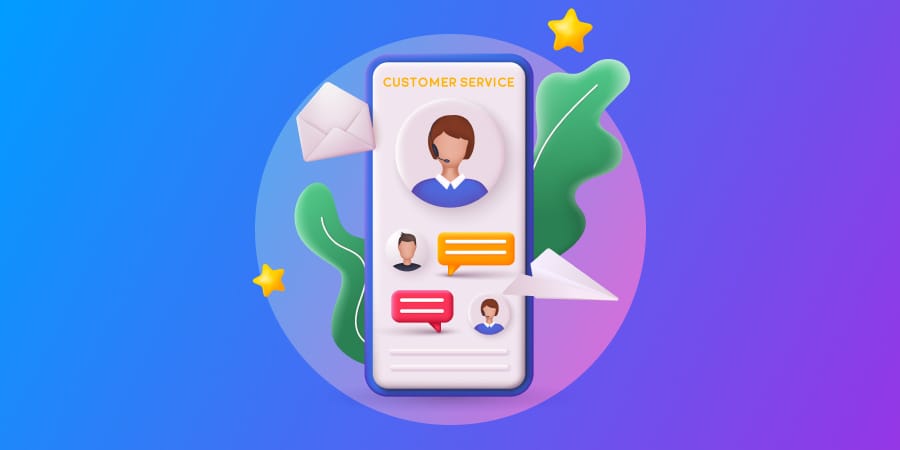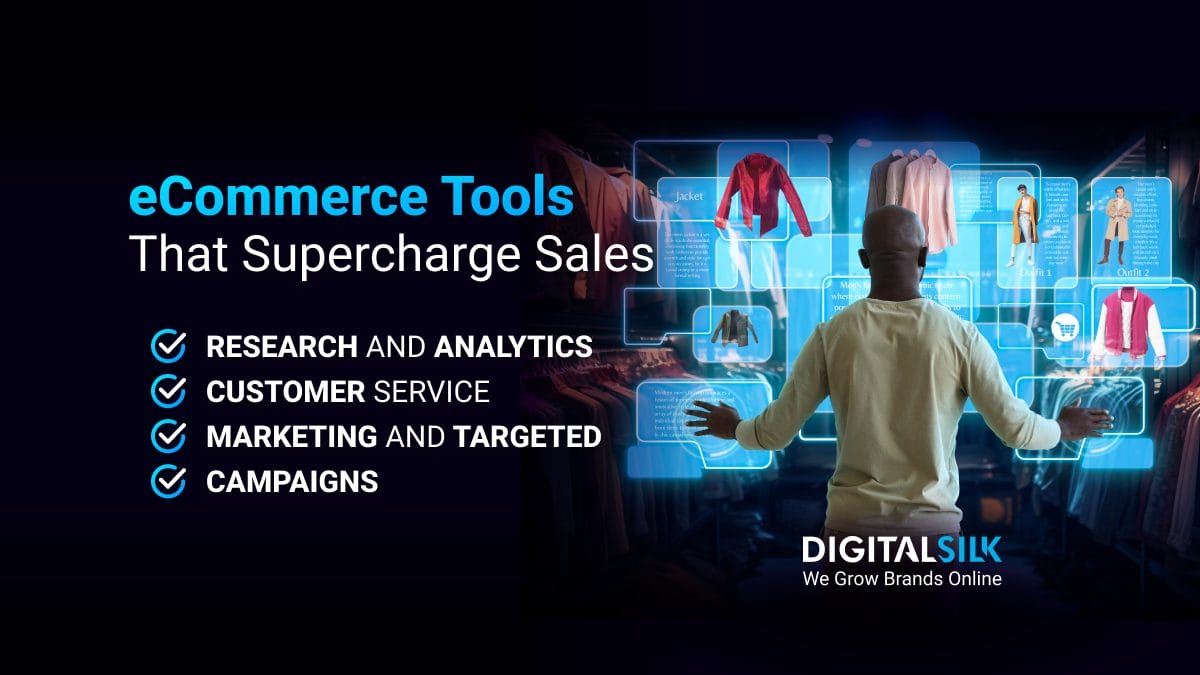The numbers are in and they are indisputable: 90% of website content gets no organic traffic!
If you need a website marketing strategy that will turn your website into a lead-generating machine, you’ve come to the right place.
We’ll show you how – step by step.
Digital Silk develops custom sites. Request a quote
What Is A Website Marketing Strategy?
A website marketing strategy is a plan of action that relies on external channels, such as search engines and social media, to drive qualified traffic to your website and help you increase conversions (read this case study and know how we increased organic traffic of one of our clients by 230%).
The main objective of every website marketing strategy is to attract the ideal target audience and increase brand awareness, generate leads and grow revenue.
How To Set SMART Goals For Website Marketing
Before creating a website marketing strategy, the first thing to do is set goals for your website that are Specific, Measurable, Achievable, Relevant and Time-based – in short, SMART.
Let’s review the three steps of setting up your SMART website marketing goals.
1. Define The Purpose Of Your Website
Your website’s purpose and goal can be one of the following:
- Brand awareness and education: I want to introduce my new brand or product to a large, targeted audience
- Lead generation: I want to attract qualified audiences and incentivize them to provide their contact details (ex. newsletter subscription) and/or schedule a call with my sales team
- Sales: I want to attract qualified audiences and increase conversions on my site (eCommerce)
- Loyalty: I want to attract existing customers and reward their loyalty and/or advocacy to increase repeat sales
Knowing your website’s purpose will help you set website marketing goals that fit your website strategy.
2. Analyze Your Competition
To set realistic website goals, check out what your competition is up to and how they are performing.
To do so, evaluate the competitors’:
- SEO performance: How many keywords are they ranking for? Which keywords are they ranking for? How many backlinks do they have?
- On-site content posting frequency: How often do they post new content to their blog or resources section?
- Social media posting frequency: What social media do they use? How often do they post on each?
- Site performance: How many monthly do they attract? What is their demographic?
There are useful online tools that can help you analyze your competition, including their backlinks, keywords and referrals, such as:
- SimilarWeb: A web analytics website that provides services and information such as clients’ and competitors’ website traffic volumes, referral sources, keyword and demographic analysis and other key metrics.
- SEMRush: A tool that provides insight into your competitors’ websites and keywords that bring organic traffic to their website
- Ahrefs: Similar to SEMRush, it lets you explore the competition’s traffic sources, referrals, keywords and ranking position

3. Define The KPIs For Your Website Marketing Strategy
Key performance indicators (KPIs) are measurable values that show your business’s progress toward a set result.
KPIs will help inform you if and when you have achieved your website’s marketing goals, such as generating more qualified leads, improving the subscriber rate or increasing awareness and trust.

The most telling website marketing key performance indicators can be summed up and categorized as follows:
Awareness level: Gain insights into your brand awareness by:
- Looking at the amount of direct traffic coming to your website using web analytics
- Reviewing the growth of direct traffic over a specific time period, which will give you information on your brand awareness growth
- Measuring the referral traffic
- Tracking your organic share of voice by analyzing your most important keywords in relation to your main competitors and your total number of mentions on social media
- Tracking your rate of organic backlinks
- Surveying and interviewing your customers
Number of qualified leads: You can track qualified leads by using customer relationship management software. Google Analytics transmits data submitted by a user through a lead generation form to the CRM platform. You can score and rank different leads to establish the most qualified among them.
Conversion rate: This metric shows how many website visitors have taken the desired conversion action, which could be anything from signing up for a newsletter or downloading a white paper to purchasing a product.
Speak with our experts. Set Up A Consultation
5 Website Strategies To Grow Organic Traffic
Methods of growing your website’s organic traffic may vary in different industries, but there are several bulletproof ways of doing this that work, regardless of your niche.
Let’s look at the five most effective strategies for growing organic traffic to your website.
1. Search Engine Optimization
When customers have a need for a product or service, one of the first things they do is turn to a search engine.
As much as 68% of online experiences begin with a search engine and search engine optimization (SEO) drives 1,000%+ more organic traffic than social media.
The logic is simple: When your prospect has a need for the type of services or products you provide, they are likely to open Google and type in relevant terms (keywords). For example:
- “Women’s shoes international delivery”
- “Best restaurants in New York”
- “Top product design agencies in Los Angeles”
An effective SEO strategy can help you rank in Google for relevant terms and entice prospects who are looking for what you have to offer. Here’s a case study showing how we helped our client develop an SEO strategy and beat Wikipedia.
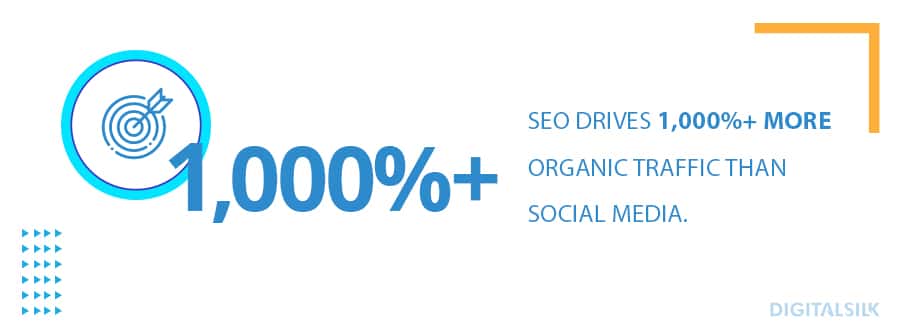
2. Pay-Per-Click Ads
Pay-per-click ads (PPC) drive traffic to websites via search engine ads. The most commonly used PPC ad networks are Google Ads, LinkedIn Ads, Bing Ads and Instagram Ads.
PPC is an effective way of driving more traffic to a website and keeping ROI rates high. On average, paid advertising returns $2 for every $1 spent.
You pay for PPC ads only when someone clicks on them.
The main advantage of using PPC lies in the targeting options. Depending on the platform you advertise on, you’ll have a different set of targeting options. The most common are:
- Location(s)
- Gender
- Age groups
Some of the more refined targeting options, like on LinkedIn and Facebook for example, may also include “interests” and more nuanced demographic filtering.
This is the secret behind PPC’s effectiveness; It helps you funnel highly targeted audiences into your website, increasing the chances for conversion.
Need help?
Agencies can help businesses create PPC campaigns with eye-catching headlines and text. Website development consultants can fully manage bidding strategies to maximize the reach and ROI of every campaign.
3. Native Ads
Native advertising means using paid ads in a way that matches the look, design and function of the website they are featured on.
They often appear as recommended content on web pages with related topics – most often, publishing platforms. Native ads blend in with the environment and look like the conceptual and contextual part of the page.
Native ads are non-disruptive because they expose the reader to advertising content without sticking out as a distraction.
Research shows that consumers look at native ads 53% more than display ads.
They also reportedly boost purchase intent with users by 18%.
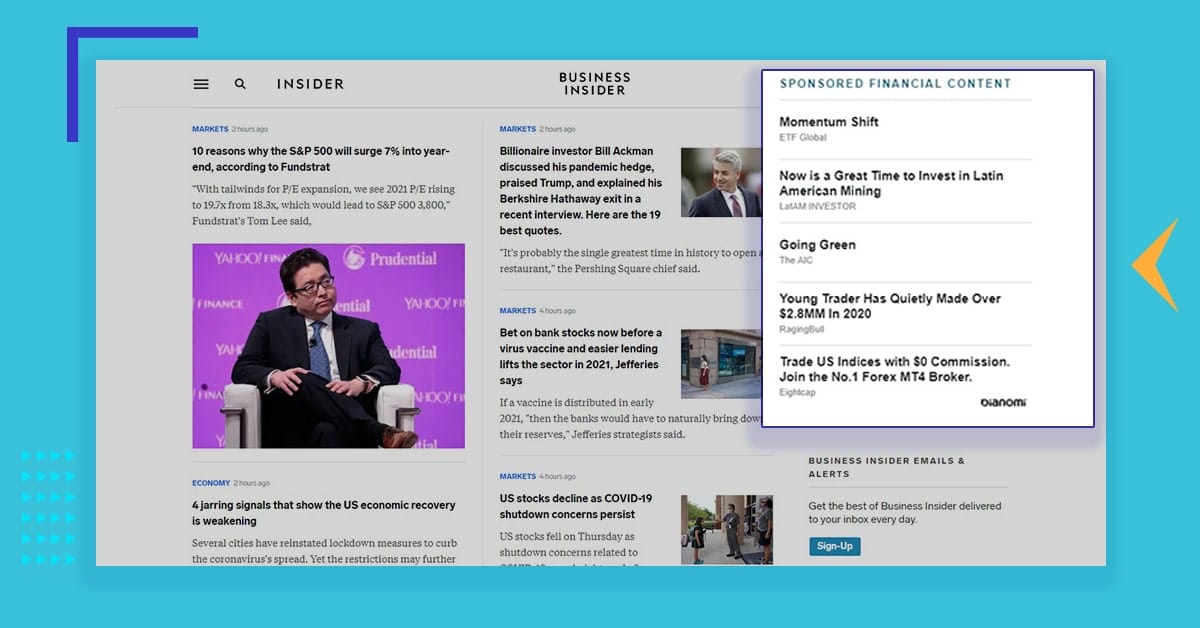
4. Email Campaigns
Email marketing is one of the most useful and effective forms of website marketing for businesses of all sizes. Email campaigns boost sales, help pull back returning visitors and reduce cart abandonment rates for eCommerce.
Email marketing is also highly lucrative – it has an average ROI of 4,200%!
As a website marketing tool, cold emails – emails sent to prospective customers with no previous contact with your organization – can help you attract new qualified audiences.
Email marketing campaigns, or emails sent to a subscriber base, can help you reengage your audience, i.e. bring them back to your website, increasing brand retention and conversions.
5. Content Marketing
Content marketing is a website marketing strategy that attracts highly qualified leads into your website’s sales funnel and forms a user journey for maximum conversion rates — speaking of, check out our guide to optimizing your conversion funnels and user journey.
In general, content marketing costs 62% less than traditional marketing and generates about three times as many leads.
Promoting your website means essentially promoting its content, so designing a content marketing strategy is a very important step in creating your website’s marketing plan.
A content marketing strategy should, when possible, strategically encompass all of these subsets:
- Blog articles
- Web copy
- Digital PR
- Infographics
- White papers
- eBooks
- Video marketing
- Checklists
- Podcasts
Why should businesses blog? Let’s hear the professional opinion of Digital Silk’s Head of Content, Emma Debeljak:
Keep reading! We’ve written about the most effective content marketing strategies here.
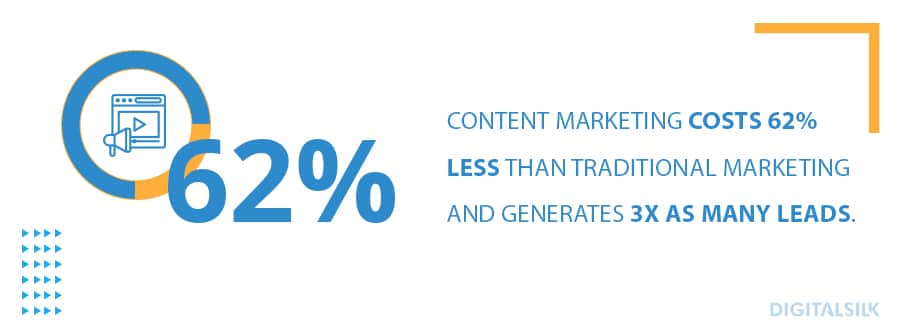
6 Advanced Website Marketing Strategies To Target Highly Qualified Traffic
In the previous section, we reviewed some methods for boosting your website’s overall traffic.
Now it is time to kick things up a notch and learn how to attract the most qualified and valuable prospects and customers to your website.
Refining your website marketing strategy to that end, best works using these steps.
1. LinkedIn Ads For B2B
94% of B2B marketers use LinkedIn as a content distribution channel and for 91% of them, LinkedIn is the best place to find high-quality content.
The essential steps for setting up a successful LinkedIn B2B ads campaign include:
- Setting your goals: Deciding whether to run a LinkedIn ads campaign depends on what you need to achieve. Some of the goals that are most easily achievable on LinkedIn include:
- Getting new leads by offering a promotion or a free demo of your products or services
- Fostering brand awareness and exposure
- Building a contact list by offering a white paper or industry report
- Targeting the right audience: LinkedIn offers a wide variety of targeting options for businesses that are targeting other business professionals. These include:
- Demographic options such as interest, age and location
- Remarketing lists for showing ads to users who have already interacted with your website
- Email lists for advertising to LinkedIn audience segments based on a list of email contacts or lists of organizations
- Choosing the right type of ads: A variety of LinkedIn ad types help advertisers reach specific goals. These ad types include:
- Text ads that are most suitable for companies looking to boost their brand awareness
- Sponsored content ads that blend in with the LinkedIn feed and are suitable for building a contact list
- Sponsored InMail ads that allow sending of personalized messages to target audiences using LinkedIn’s internal messaging system
2. Facebook & Instagram Ads For B2C
More than 1.8 billion people use Facebook daily. Instagram, on the other hand, boasts over 500 million daily users, while its total potential advertising reach is 849 million users!
When it comes to the benefits of advertising to Facebook and Instagram audiences, these numbers speak for themselves.
Facebook and Instagram ads are a highly effective website marketing strategy for these reasons:
- Great targeting breadth: The specificity and possibilities of Facebook and Instagram ad targeting are immense. You can target and narrow in the most specific target audiences that are most likely to become your customers in several easy steps.
- Sufficient ad exposure: Facebook algorithms ensure that users do not see too many ads from the same advertiser, making it a potentially fertile ground for marketers.
- Command of attention: Facebook and Instagram ads are difficult to ignore because they are embedded right into newsfeed and even Instagram stories.
- They work for all businesses: B2C companies of all profiles and in all industries can find their ideal target audience on Instagram and Facebook through very granular targeting.
3. Google My Business For Physical Stores & Local SEO
64% of consumers use Google My Business to find a business’s contact details, including the company website.
In fact, the most common action users take after viewing a company’s Google My Business page is going to their website!
GMB increases business discovery – potential customers will find your business 852 times from discovery searches and 157 times from direct searches.
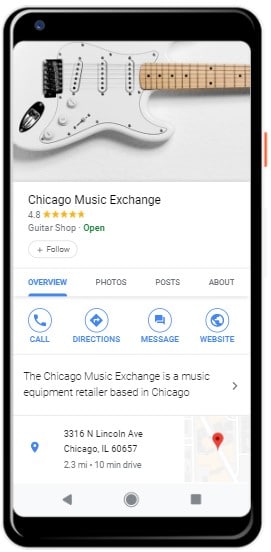
With GMB, website marketers can:
- Target local customers: Google shows search results based on a searcher’s location in order to display the most relevant information. Local businesses appear higher in search results and, according to Think With Google, three in four users who find local information in search results helpful will reach out to the business.
- Take control of their online reputation: GMB includes customer reviews. 88% of shoppers read online reviews to establish local business quality. You can verify and manage customer reviews under your GMB account in order to understand the level of customer satisfaction with your business and website.
- Gain local shopper data: GMB provides insight into who is searching for your business profile – information that can be very helpful when creating future website marketing campaigns. This info includes:
- How users found your business – through a direct search, branded or discovery search
- Where users are located
- What actions users are taking on your business profile
- Increase website traffic: Having a GMB listing is an affordable way for you to promote your business to target shoppers. Also, adding and posting attractive content on the GMB page is an easy way to increase your store traffic and engage prospects. Having good reviews, clear contact details and professional photos on GMB will help you build business credibility and increase your presence in search results.
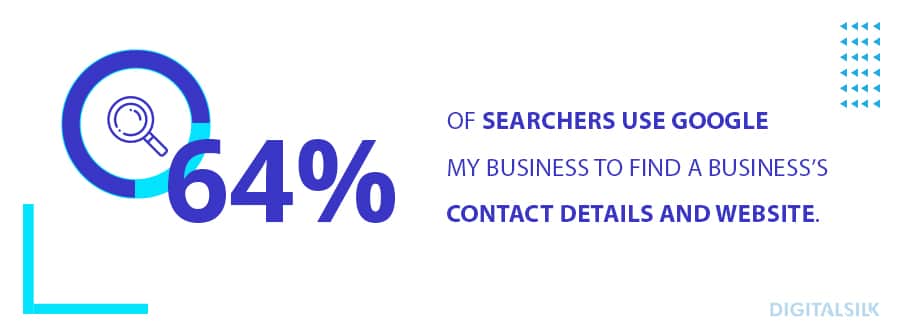
4. Influencer Marketing
Influencer marketing uses the reach and impact of an influential online figure with a large following and a strong brand reputation in a certain niche to support your brand.
89% of marketers say ROI from influencer marketing is comparable to or better than other marketing channels.
Influencers can endorse your brand or website and co-create content in order to drive your sales and increase general brand awareness.
To make the most of influencer marketing as a website marketing strategy, you need to:
- Find an influencer whose values align with your brand’s: When you have a clear idea of who your ideal customer/website visitor is, it will be easier to find an influencer that reflects your values and whose audience is also your audience. Find influencers who are of interest to your users and who are in the same niche as you. These influencers will speak about your website and your business in a more authentic way to your ideal audience.
- Review the influencer’s analytics: Make sure the influencer you choose has a genuine following and that they’re able to have an impact on their followers. For instance, observe how many comments and views their posts get on Instagram in relation to the number of followers they have. Adding up different metrics like these can provide you with an idea of how authentic their following actually is. SocialRank platform can also provide you with this insight,
- Set goals for your influencer campaign: Figure out what the end goal for your influencer website marketing campaign is. Do you want to:
- Increase visits to your website? If so, how much of an increase are you looking for?
- Raise awareness of your products and services? How many impressions are you hoping for?
- Acquire highly qualified leads who are ready to purchase?
- Direct the influencer’s audience to download a whitepaper/eBook/sign up for newsletter?
5. Guest Posting
Guest blogging is a content marketing strategy that consists of writing for an online publication that is not your own.
Guest posting increases organic and referral traffic by 80% and allows a 174% audience extension and brand awareness growth.
Guest posts as a website marketing strategy should include a link to your own website.
Mentioning your website and linking to it on a website with a high domain authority will generate highly qualified traffic, provide an SEO boost and contribute to your reputation as an industry expert.
When creating guest blog posts in order to market your website, it’s important to follow these best practices:
- Align your content with your business’s services: The link you use in the guest blog post should add value to the content and also lead to the page on your website that is relevant to the topic.
- Link to high-quality content: Guest posting is your opportunity to establish yourself as an authority in your field, so make the most of it.
6. Targeted Thought Leadership
60% of business decision-makers said that thought leadership prompted them to work together with an organization.
Thought leadership is a marketing method that establishes your brand as an expert authority in your industry.
Thought leadership’s goal is to provide an entry point to your business by solidifying you as a source of expertise in your field. It is a subset of content marketing that taps into the talent and experience within your organization.
To build thought leadership that attracts your target market, one of the best ways to establish authority on your topic is to produce deep research on the subject.
Remember, you have to present in-depth knowledge that no one else in your industry has.
To do that, follow these steps:
- Tap into questions your potential customers are asking: Turn to forums like Reddit, Quora, Yahoo Answers, UberSuggest and others to find out what questions your target audience is asking about your business. This informs the content you should create and the questions you should answer.
- Revise these questions regularly: Industry trends evolve and new products and services pop up continuously. That’s why answers to old and new questions also change. To stay ahead of the curve, look up to tools like Google Trends and keep your knowledge base up-to-date.
- Display your thought leadership beyond blog articles: Even though your website’s blog section should be the main source of expert knowledge, posting your thought leadership content on other platforms is also critical for discovering new audiences and potential customers. Guest posting is a great way to reach out to relevant and highly qualified audiences interested in your expert knowledge.
- Brand your business: While creating an entry point and building trust with your prospects through thought leadership marketing, seize the opportunity to brand your business by demonstrating how well you understand your B2B clients’ pain points and needs. Create thought leadership content that supports your brand identity and your style in all of its facets.
Website Marketing Strategy Takeaways
A website marketing strategy is a series of steps and tactics a business should take in order to establish itself as an industry authority, generate the highest number of qualified leads and outrank competitors.
Each website strategy should begin with setting SMART website goals by:
- Defining your website’s purpose
- Analyzing your competitors
- Establishing KPIs
Market your website’s unique selling points to a more qualified audience.
At Digital Silk, we provide an extensive list of marketing services you can utilize from SEO strategy to content marketing and beyond:
- SEO
- PPC
- Native ads
- Email marketing
- Content marketing
- B2B LinkedIn ads
- B2C Facebook and Instagram ads
- Google My Business
- Influencer marketing
- Guest posting
- Thought leadership
"*" indicates required fields




